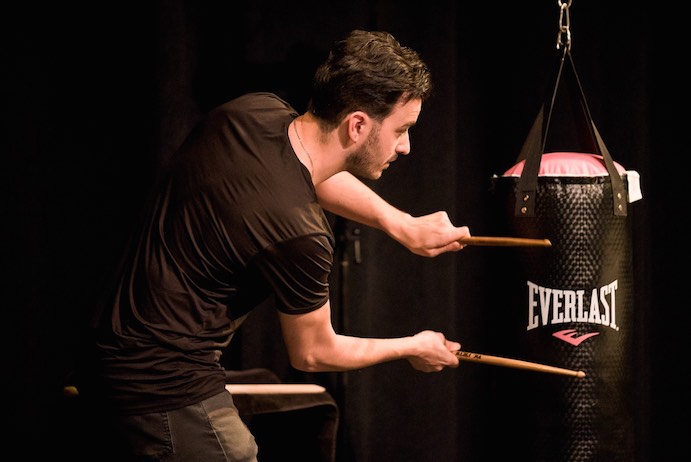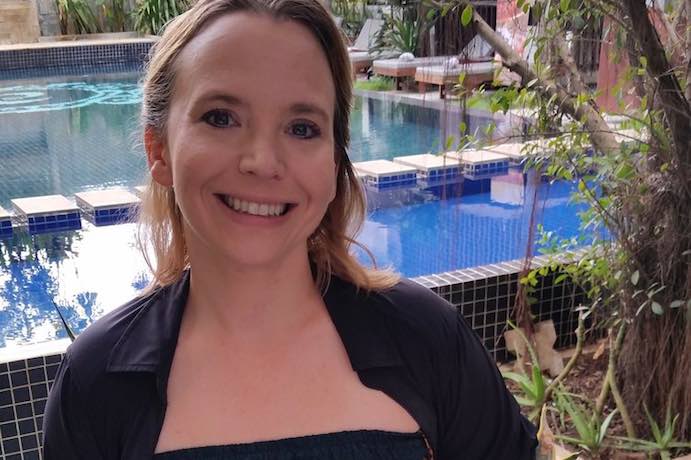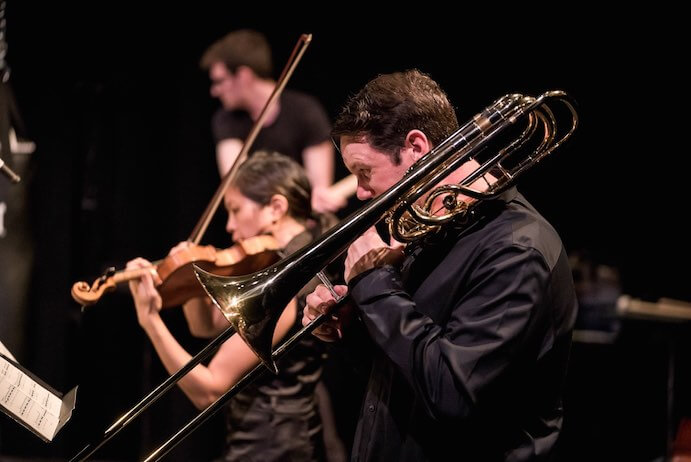Diversity is important to MATA, said Artistic Director Du Yun, and diversity beyond race: “diverse expression, style, and syntax of the musical language that we share.” To that end, MATA 2017’s festival finale “Dangerous Currents,” presented on April 29th, 2017 at The Kitchen, was a mature offering of inspiration, form, and content performed by Trinity Wall Street’s NOVUS NY and The Le Boeuf Brothers jazz quintet. Dramatized speech, bird sound imitation, and formal play emerged as trends of the evening, while extended techniques and the omnipresent accordion appeared in more refined form.
The opening piece was a startling direct rebuke. Paul Pinto’s Letters from Brown Men (2015) originally premiered in Queens, New York as the finale to an opera on Hurricane Sandy and commented on the disproportionate effect of disasters upon the global poor. Karen Kim on lone violin sustained a high marathon spiral while four other instrumentalists introduced and embellished Jonathan Woody’s bass-baritone narration of letter excerpts. After the global panorama, the violin faded as Woody read final “Letter from yourself: Date. Place.” You, the letter said, have the luxury of viewing poverty with sentiment and detachment. You are protected from browning labor under the sun. You see a porch with its “rotted two-by-fours” and construct an ideal of summer bluegrass instead of tangible change for the neighborhood. But you can choose differently: “Some things may have changed since then.”
Next was Angel (2007), Dmitry Timofeev’s elegy to his father. Inspired by the sound of migrating sand hill cranes, Timofeev’s delicate balance of motion, height, and weightlessness created an otherworldly atmosphere. Two violins tuned a quarter tone apart droned high and thin while two clarinets flew among them, both swaying on melodic minor thirds. The violins and clarinets mourned in doubled and solo exchanges before a cold front moved into the texture. The violins slid away from each other, the clarinets fluttered and ceased, and french horn, trombone, cello, and contrabass wove in like souls in motion. Wispy harmonic shapes were quickly blown away as the violins evolved into evocative bird sounds, opening a trance portal while staying tethered to earth.
Philip Venables’ The Revenge of Miguel Cotto (2012) captured the theatrics of boxing by blending physical violence with the poetic expression of Steven J. Fowler, a former professional fighter. The piece was violins and vocals until rhythm entered with a smack. Two players slapped suspended punching bags with wooden paddles while three trombones, three violins, two male vocalists, and an accordionist expressed the boxer’s pathos. The sound was cracking and extended minutes on end. Damped trombones and vocals offered bruised reflection and a quick break before the bag players re-entered, this time drumming on the bags’ metal suspension chains. Meanwhile, the vocalists sang and spoke phrases that left them panting for breath. One section required endless rolled Rs that left the singer heaving. “Apologies,” he says, “an animal shaped like a bubble …” before a frantic explosion: the beaten punching bags spit their sound, the instruments and singers voiced a mob, the tired bag players watched frantically for the cue to stop: “he is banned for one year!” The bags’ actual sound was novel and they were used effectively to musical and dramatic purpose. As the performers’ bodies were pushed to excretion, the work became its own brutal fight and mocked any false audience sophistication.

NOVUS NY performs Philip Venables’ The Revenge of Miguel Cotto–Photo by Steven Pisano
The audience returned from intermission to a stage crowded with violins, viola, accordion, double bass, cello, violin de gamba, 2 gongs, triangle, alto sax, trombones, and French horn. Out of the hodgepodge arose a stunning piece of rich humanity and earthen transcendence, inspired by the Zen concept of reflection on water and Kristina Wolfe’s experience on the Camino de Santiago. Record of Ancient Mirrors (2017), a MATA commission, traced a clear dramatic arc but used the violin de gamba to build myth and flex time. Timbres fluttered in and out. Gong overtones painted the space. Strings overlapped bowing speeds and techniques; at one point the violins, sounding like birds, were so resonant it seemed an amplified recording had joined the texture. The violin de gamba bubbled to the surface in a folksy tune; after a resonant unison silence, the gamba opened the second section whirling through its most extreme registers. Doug Balliett played with grit and modernity, almost like electric cello, before the ensemble flooded back. Brass brought valiance and an anchored sense of tradition hovered in faint tonality. The piece evolved into silence through unpitched sounds and awareness of breath.

Kristina Wolfe
Newcomer Pascal Le Boeuf’s Alkaline (2014) brought MATA back to 2017. A renowned jazz pianist, Le Boeuf is the reverse of classical musicians pushing past labels. He noted that there is no big distinction between performer and composer in the jazz world, so accepting “composer” as a distinct musical identity has taken time. Le Boeuf led his work for jazz quintet and string quartet from a prepared piano using mashed chords and mallets. Each ensemble sacrificed part of its style to co-exist, and in return gained an element of freshness. The string quartet took on gritty panache; the quintet grooved with crisp solos. The piece was cohesive through good-natured listening, and unison sections of extended techniques and frantic energy were playfully “unstable and never quite resolved.” The piece ended with all players sliding up towards a grand finish and decaying piano bass. It was fitting end to the MATA 2017 festival that showcased flexible listening, sincerity, and acceptance of both self and other.






















